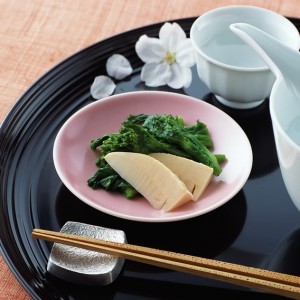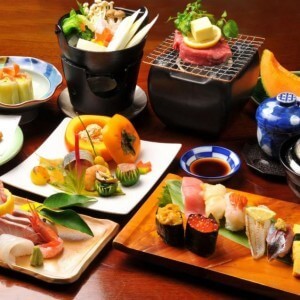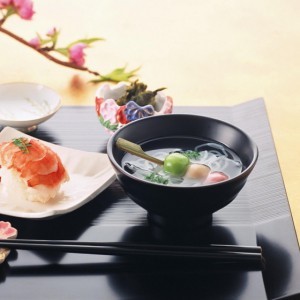
The Japanese diet is a low carb and low calorie diet developed by Japanese nutritionists with a protein menu that allows you to lose about 10 pounds in 2 weeks.
Being overweight these days, many people call it pay for an incredibly fast lifestyle. We are in a hurry to live, we are in a hurry to work, we are in a hurry to eat. . . Moreover, we often eat while running and with what, as they say, God sends. And in the 21st century, God is increasingly sending burgers, hot dogs, cheeseburgers and soda. . . - What to do? Don’t waste precious minutes having lunch at a restaurant or what? - to cook independently in the kitchen when the store "burns"? Here they say that the whole successful world lives like this and nothing. "This objection is made by some people who have a great active lifestyle. And when your favorite jeans don't fit, when you have to buy a longer belt, when a seductive skirt that fits snugly around your waist, and an ugly, shapeless style with elastic band, thewe choose the second one, of course it's time to come up with a new excuse. Well, in reality - it's not, of course, the result of malnutrition, it's simply . . . thick bone Yes, yes, and there's nothing to do about it, thick bone - it's very, insidious. begins to grow - everything is impossible to stop.
Let us now turn our attention to Japan, a country of great potential, the highest level of technological development and an incredible pace of life. It seems that if someone doesn’t have time to take a break from a proper meal, it’s like the Japanese. But surprisingly, he rarely encounters "thick bones" among Japanese residents. . . So what's the secret?
The thing is, Japanese snacks are low-calorie foods, high in protein, almost fat-free and "bad" carbs. The main principle of the Eastern food tradition is moderation. That is why Japanese cuisine is called one of the healthiest foods in the body.
Taking into account the peculiarities of the Eastern tradition of nutrition, a balanced and highly effective diet was created under the Japanese name. In fact, there is virtually no traditional Japanese cuisine on the menu of this diet. But there is a combination of other isa proteins, fats, and carbohydrates, in amounts that are exactly necessary for the body to get everything it needs without provoking it, while at the same time making the bone "thicken. "There are many dietary options, but the most popular is the Japanese salt-free diet for 14 days. A proper "Japanese" diet for two weeks will help your "thick bones" lose more than 10 pounds more and will easily maintain the result for several years.
The essence of the Japanese diet
Those who choose to go "Japanese" need to be patient and deviate from their usual diet for two weeks. For many, dieting may seem like a rather difficult challenge, but the effect doesn’t last long. But the amazing results will last for years. Only the two-week system of the "Japanese woman" - and ten pounds (sometimes even more - it all depends on the initial weight).
So what's the main secret? Why is the Japanese diet better for a week than other nutritional systems in terms of weight loss? What wonderful ways does weight loss help those who have tried many other diets on their own without success?
Carefully selected products are on the diet menu - they are combined to speed up the metabolic process as much as possible. Therefore, it is very important to strictly follow all instructions, only those indicated to eat, not to "improve" other products, even if at first glance they seem to be completely interchangeable. It is also not recommended to change the menu days.
For many women, the degree of "hunger" is important when choosing a diet, as not everyone is able to fight the samurai's willpower against their own desires, especially the old instinct of all living beings - hunger. Therefore, the fact that the two-week Japanese salt-free diet is not a "hungry" diet. By following this, you don’t have to chew a cabbage for weeks and drink low-fat kefir, cursing yourself, your excess weight, and those who have made a diet. The Japanese woman's menu contains interesting and delicious recipes. This diet is especially appealing to those for whom breakfast is usually just coffee. Meat and fish lovers don’t see anything difficult. This is the best diet for them.
The essence of the Japanese diet can be explained simply in two words - slowness and efficiency.
"Japanese" is a low-calorie protein-fiber diet. Minimized carbohydrates in the daily diet force you to lose weight faster - in need of energy, the body processes its own fat reserves into joules. But it’s important to note something else: a Japanese woman’s diet doesn’t allow the body to saturate with its full spectrum of vitamins and minerals. Therefore, it is strictly forbidden to go on a diet longer than prescribed (up to 14 days) so as not to end the diet in the hospital bed.
And if you want to feel like a real Japanese, you can try Japanese sticks instead of a traditional fork and spoon for Europeans. Not only do they convey the fabulous spirituality of the land of the Rising Sun, but they also teach eating slowly and in small pieces. This trick, by the way, is familiar to many proponents of diets. A loose meal can fool your body and make you feel good even after very small meals. This is actually what the Japanese should teach diet weight loss.

Types of the Japanese diet
The immense popularity of the Japanese diet among women around the world has led to the emergence of more opportunities for this system to lose weight. In particular, the dietary options are known:
- Japanese salt-free diet for 7 days;
- for 13 days (the most commonly used diet);
- for 14 days (deviates from the previous 13-day diet by only one day);
- Japanese woman with green tea;
- Naomi Moriyama's diet.
Proponents of these techniques call their favorite version a "real" Japanese woman. Moreover, in the debates over diet authorship, many mines have already been broken. Some say it was invented by Japanese nutritionists, others would argue that the system has nothing to do with the East. Whoever is the author of the Japanese diet, the most important thing is to work. And the effectiveness of donuts has been experienced by millions on the planet.
The dieting Japanese diet menu includes foods that contain minimal calories, carbohydrates and salt, spices, sugar and sweet confectionery, as well as any alcohol, so the diet can be considered strict. This contributes to the rapid breakdown of fat in body fat as the body is put in a stressful situation and is forced to burn its own fats and calories.
Diet menu for 7 days
The 7-day Japanese diet is a light version of the traditional Japanese diet, while the 7-day diet is the basis of the whole diet.

Predicted results: 3-5 kilograms left from the past.
Disadvantage: the longevity of the result is not guaranteed because the body has not yet had time to adapt to the new metabolic system.
Day 1
Calorie content of the daily diet: 700 kcal.
Required products:
- black coffee;
- chicken eggs;
- fresh cabbage (Peking cabbage / white cabbage);
- tomato juice (ideally freshly squeezed);
- Low fat fish.
Breakfast:
- black coffee - it is better to prefer espresso, but it is better to forget about sugar.
Lunch:
- boiled chicken eggs (2 pieces possible);
- "Japanese" salad - fresh cabbage and little vegetable oil, no need to add salt;
- A glass of tomato juice.
Dinner:
- steamed fish - hake, cod, pollock ideal (portion up to 200 grams);
- Japanese salad.
Day 2
Calorie content of the daily diet: 1000 kcal.
Required products:
- coffee;
- rusks;
- fish (fatty species);
- cabbage; vegetable oil;
- beef;
- kefir.
Breakfast:
- coffee;
- rusks - take a smaller one, about 30 grams.
Lunch:
- Fish, fried or steamed - For variety and further consumption of fatty acids, it is better to prefer catfish, salmon and black halibut. Not more than 150 grams in total;
- "Japanese" salad.
Dinner:
- beef - boil for approx. 200 grams. Consume without salt;
- kefir - can be skimmed, but not more than 200 grams.
Day 3
Calorie content of the daily diet: 1000 kcal.
Required products:
- coffee;
- zucchini / parsnips;
- apple;
- chicken eggs;
- veal;
- cabbage;
- Vegetable oil.
Breakfast:
- black coffee - don’t forget the sugar moratorium.
Lunch:
- zucchini (large enough) or parsnips root (also large) - brown in vegetable oil (do not use flour or dough for frying, salt is also forbidden);
- apples - don't get caught, it's a good idea to limit yourself to one fruit.
Dinner:
- boiled chicken eggs - 2 pieces;
- cooked veal - limits appetite to 200 grams of salt-free prepared;
- "Japanese" salad.
Day 4
Calorie content of the daily diet: 1000 kcal.
Required products:
- coffee;
- carrots;
- hard cheese;
- chicken eggs;
- apple.
Breakfast:
- Black, non-sugary coffee.
Lunch:
- carrots - bring to a boil, it is allowed to have 3 larger roots;
- some cheeses - choose from hard varieties, limit yourself to 20 grams;
- raw chicken eggs - just one.
If desired, all the ingredients of a 4-day lunch can be combined into a single dish - a salad.
Dinner:
- apples - more fruit allowed.
At this point, the feeling of hunger will no longer be as strong as it used to be. Filling occurs after a small portion of a meal.
Day 5
Calorie content of the daily diet: 800-1000 kcal.
Required products:
- carrots;
- lemon juice;
- sea fish;
- juice;
- fruit.
Breakfast:
- carrots and lemon juice - grate the vegetables and season with juice. You cannot add sugar. Breakfast and coffee were also excluded on this day.
Lunch:
- fried fish - take about 350-400 grams, variety - from any sea;
- tomato juice - for dieting it would be better to use it freshly prepared yourself. Volume - up to 200 grams.
Dinner:
- Fruit - but under no circumstances should you consume any kind of grapes or bananas, especially before going to bed. All the results achieved so far will be drawn.
Day 6
Calorie content of the daily diet: 900-1100 kcal.
Required products:
- coffee;
- chicken fillet;
- raw cabbage;
- carrots; vegetable oil;
- chicken eggs.
Breakfast:
- Black, non-sugary coffee.
Lunch:
- chicken fillet - limit the dose to 500 g, take meat without skin. Boil in water without adding salt;
- salad - on this day, the traditional "Japanese" salad can be improved by adding grated raw carrots.
Dinner:
- chicken eggs - boil 2 pieces;
- carrots (you can buy a big one) - grate a raw vegetable, season the salad with a small amount of vegetable oil (possibly olive oil).
Day 7
Calorie content of the daily diet: 700-800 kcal.
Required products:
- tea;
- fruits;
- beef;
- eggs;
- cabbage;
- Vegetable oil.
Breakfast:
- tea - it is advisable to choose good green varieties that are rich in useful antioxidants.
Lunch:
- beef - boil for approx. 200 grams each. Do not use salt or other spices while cooking;
- fruit - you can offer yourself a lunch dessert on the last day of your diet. But let us not forget the ban on the use of bananas and grapes.
Dinner:
For dinner this day, you can choose any dinner option from the previous days to reward your stamina. For example, choose a version of a beef, egg and cabbage salad flavored with olive oil.
This will end the diet for some. For those who have opted for a longer version of the Japanese woman, Day 7 is just the equator for working to change ourselves.
For those who don’t eat by counting calories, “Japanese” at first seems like a rather difficult option to lose weight. But the discomfort will only be noticeable in the first few days - then the body will adapt to small portions of food, starting to eat faster. After 5 days of a new diet, the first stage of restructuring in the body speeds up the metabolism - the main goal of any diet is to reduce excess weight, remove excess fluid, and the edema disappears. For best results, use an anti-cellulite massage regimen in parallel with your diet.
Japanese diet for 13 days
The 13-day Japanese diet is the most popular. This version counts as a complete diet.
Predicted results. If you are ashamed to comply with all the regulations, then at the end of the 13-day day, you weigh about 10 pounds and about. 30 cm is missing (sometimes more).
How is it different from the 7-day option? In fact, this is a continuation of the easy version of "Japanese Woman. "That is, you have to go through a 7-day "Japanese" life and start on day 8 from the beginning, repeating the days from the first to the sixth.

Japanese diet for 14 days
The 14-day version of the Japanese diet was also based on the 7-day menu, albeit with some nuances. The main difference from the previous two options is that the 7-day menu must be strictly adhered to in the first week and in the second week according to the same program, but in the reverse order. This means that the diet of the eighth day will correspond to the last day of the 7th day, the diet of the ninth day - the menu of the 6th day, the tenth - the menu of the 5th day. . . And according to this principle, continue until the end of the second day. As a result, complete the last 14 days of your diet with the diet of the first day of the 7-day version of "Japanese Woman. "
From day 8 of the diet, the body activates the detoxification process, and thanks to the principle of salt-free nutrition between cells, excess fluid is removed, completely eliminating the edema. It is important that in the second week of the diet, the body gets used to the rate of the new metabolism. As a result, even after switching to a normal diet (normal - this doesn’t mean you have to eat in the pools again for your next sleep, but you don’t even have to live in “hunger” mode) your body won’t gain weight, on the contrary - your fat will go just as fastburn like during the diet. This amazing effect will last for about 2 years. But provided the diet was followed correctly. Those who have already experienced the work of the "Japanese woman" claim that a year later after completing their diet, the weight continues to adjust downwards. If you repeat the "Japanese woman" again (but not earlier than six months after the first course of treatment), then in a year's time, with virtually no effort, you can actually get rid of 20 kg of excess weight.
Diet and salt
Have you ever wondered why almost every more or less effective diet contains taboos about salt? The situation is that, according to experts
1 gram of salt retains one liter of fluid in the body.
And that's nothing more than a kilogram overweight. In addition to false overweight, because weight is accumulated not by the fat layer but by the stagnation of the fluid due to salt, consuming excessive salt causes other problems for people. A few days of salt-free meals can also lower blood cholesterol levels and improve the condition of blood vessels.
Of course, it is impossible to completely eliminate salt from consumption, and that cannot be done. But the "Japanese woman" menu contains products that already contain a certain amount of salt - enough for the organs to function normally. Especially organic salt is found in some vegetables, fish, meat. During dieting, it is impossible to eat canned vegetables, smoked meats, semi-finished products - all of which contain quite a large amount of table salt.
Green tea
In addition to the classic version of the Japanese diet, there is an option on the menu that recommends using green tea instead of coffee. Many nutritionists believe that this version of the "Japanese woman" is more beneficial to the body.
Considering that the Japanese diet is based on a protein-rich diet, it is important that green tea (especially its Japanese form) is high in protein, and in terms of nutritional value, this drink does not lag behind legumes.
In addition to green tea, the second plus is the presence of antioxidants that protect the body from toxins and help remove toxins.
Third, and probably the most important for those who lose weight, the unique chemical composition of green tea speeds up your metabolism by 4 percent (it burns 60 calories a day more than without green tea).
The Japanese green tea diet lasts for 2 weeks. The components are virtually identical to the classic version of "Japanese, " although there are still excellent features.

Detailed Japanese green tea diet menu
Day 1 / Day 14
Breakfast:
- green tea - glass;
- fat-free cottage cheese - 150 g.
Lunch:
- Cabbage steamed with butter - 300 g;
- boiled chicken eggs - 2 pieces;
- Fresh apples - glass.
Dinner:
- in vegetable salad or steamed;
- cooked or steamed fish - 200 g.
Day 2 / Day 13
Breakfast:
- green tea - glass;
- hard cheese - 2 pieces;
- toast or diet biscuits.
Lunch:
- cooked or raw cabbage flavored with oil;
- cooked fish;
- glass of green tea.
Dinner:
- vegetable salad;
- boiled veal - 300 g;
- boiled chicken eggs - 2 pcs. ;
- Japanese green tea - glass.
Day 3 / Day 12
Breakfast:
- Japanese green tea - glass;
- dietary cookies.
Lunch:
- boiled zucchini / cauliflower;
- apples - 1 pc;
- glass of green tea.
Dinner:
- yellow-green vegetable salad;
- cooked veal;
- boiled chicken eggs - 2 pcs.
Day 4 / Day 11
Breakfast:
- Japanese green tea - glass;
- fat-free cottage cheese - 150 g.
Lunch:
- raw grated carrots with olive oil;
- chicken eggs;
- green tea without sugar.
Dinner:
- green tea;
- fruit (not grapes and bananas).
Day 5 / Day 10
Breakfast:
- green tea - glass;
- croutons with jam - 2 pcs.
Lunch:
- boiled fish - 200 g;
- tomato juice - glass.
Dinner:
- vegetable salad;
- hard cheese - 2 pieces;
- glass of green tea.
Day 6 / Day 9
Breakfast:
- rye flour with croutons - 2 pcs;
- Japanese green tea - glass.
Lunch:
- Cooked with raw cabbage / olive oil;
- cooked chicken without skin - 400 g;
- Japanese tea - glass.
Dinner:
- carrots (cooked / raw);
- boiled eggs - 2 pieces;
- unsweetened green tea.
Day 7 / Day 8
Breakfast:
- Japanese tea - glass;
- cheese (any hard variety) - 2 small pieces.
Lunch:
- boiled veal - 200 g;
- cooked / steamed vegetables;
- green tea without sugar - glass.
Dinner:
- fruit - any;
- Japanese green tea - glass.
The effectiveness of this version of the Japanese diet is enhanced by the addition of green tea to the diet, and the variety and flavor of the menu makes it easy to move the period of eating restrictions. Repeat the diet - at the earliest a year later. And the results achieved in two weeks lasted longer, in the future it is advisable to follow a healthy lifestyle, eliminate tobacco and limit alcohol intake, and adhere to proper nutrition in everyday life.

Main courses
Whatever Japanese diet you choose, any one will have a traditional cabbage salad and cooked meat. These dishes can be prepared in different ways. But keep in mind that these are part of the diet and the cooking process is slightly different from cooking. casual meals.
To prepare the right Japanese salad:
- Take raw or slightly cooked cabbage (common or Peking cabbage).
- Finely chop.
- You can easily displace excess moisture.
- Season the prepared salad base with olive or sesame oil.
- Mix and let cook.
Dietary cooked meat
- Prepare meat. If chicken, remove skin. Peel veal or beef from the film.
- Rinse thoroughly with cold water.
- Put the meat in a pot, cover with very cold water.
- After boiling, drain the water, rinse the meat and refill with water, put on top.
- Cook until soft, without the addition of spices.
Tip: Add an onion, a little carrot, and a little vegetable to the water to improve the taste while cooking. Many are curious about how to replace beef in the Japanese diet. It is permissible to introduce young veal into the menu, which is easier to digest, but with this its chemical composition is the same as that of beef.
How were the products selected?
According to almost all sources, the list of foods allowed in the Japanese diet is special and should not be changed. So what is the secret of this diet?

Coffee. Many people start the day with this aromatic drink. A cup of black ground coffee serves a traditional breakfast and a Japanese diet.
What's the benefit?
Sugar-free black coffee, which has an invigorating effect, helps the body wake up faster and start burning calories. And since food intake is not provided by the morning diet, the body begins to burn energy to produce its own reserves - subcutaneous fat.
You can decorate the taste of your breakfast drink by adding vanilla, dark chocolate or citrus fruits. Add additional ingredients in small portions.
Cabbage. This vegetable was not chosen for the diet by accident. In addition, cabbage is one of the so-called "minus" calorie-rich vegetables (the body spends more energy on digesting than it gets).
What's the benefit?
Cabbage, white or Beijing cabbage strengthens the walls of blood vessels, lowers cholesterol and cleanses the intestines. For people who are prone to intestinal tension, it is better to boil the cabbage slightly before use.
Olive oil. A teaspoon of oil added to the salad normalizes metabolism and has a beneficial effect on the liver, kidneys and pancreas.
Eggs. This product has good nutritional properties, an excellent source of protein, fat and carbohydrates, as well as many vitamins and minerals.
Tomato juice. Nutritionists call it one of the healthiest. The unique chemical composition of tomatoes serves to prevent cardiovascular and oncological diseases, speeds up metabolic processes in the body, improves mood and has a beneficial effect on the nervous system. It is mostly absorbed without added salt, which is especially important for a salt-free diet.
Hal. It is known for its ability to quickly remove toxins and toxins. A valuable source of protein and amino acids. It acts on the body as a preventative measure against stroke.
Fruit. Diets usually need to drastically reduce the amount of carbohydrates consumed. But it is completely undesirable to exclude them from the diet - they are an important source of energy. The body gets “right” carbs along with fruits. But it is better to exclude high-sugar bananas and grapes from your diet.

Naomi Moriyama's Diet
It’s hard not to believe in the effectiveness of the Japanese diet, especially for those who have yet decided to try themselves. But sooner or later, many people ask themselves the question: why is this diet called a “Japanese diet” when there is virtually nothing on the menu? from traditional dishes to the land of the Rising Sun. But there is an explanation for this. According to one version, this original diet is developed by the nutritionists of the Japanese clinic "Yaelo".
But there is another version of "Japanese" created by marketer Naomi Moriyama - in response to Frenchman Mireille Guiliano, author of "Why French Women Don't Lose Weight. "In fact, research shows that the French are not the slimmest in the world at all. The least obese people live in Japan - only 3 percent, while donuts are about 11% in France and more than 32% in the United States. So Naomi gathered the nutritional principles typical of her people and turned them into a diet.
Food rules from the country of the rising sun
Easterners consume nearly 100 different foods a week that are more than a quarter lower in total calories than, for example, the weekly caloric intake of Americans. And the only secret to the harmony of the Japanese lies in a simple rule: fill your stomach with 80 percent.















































































